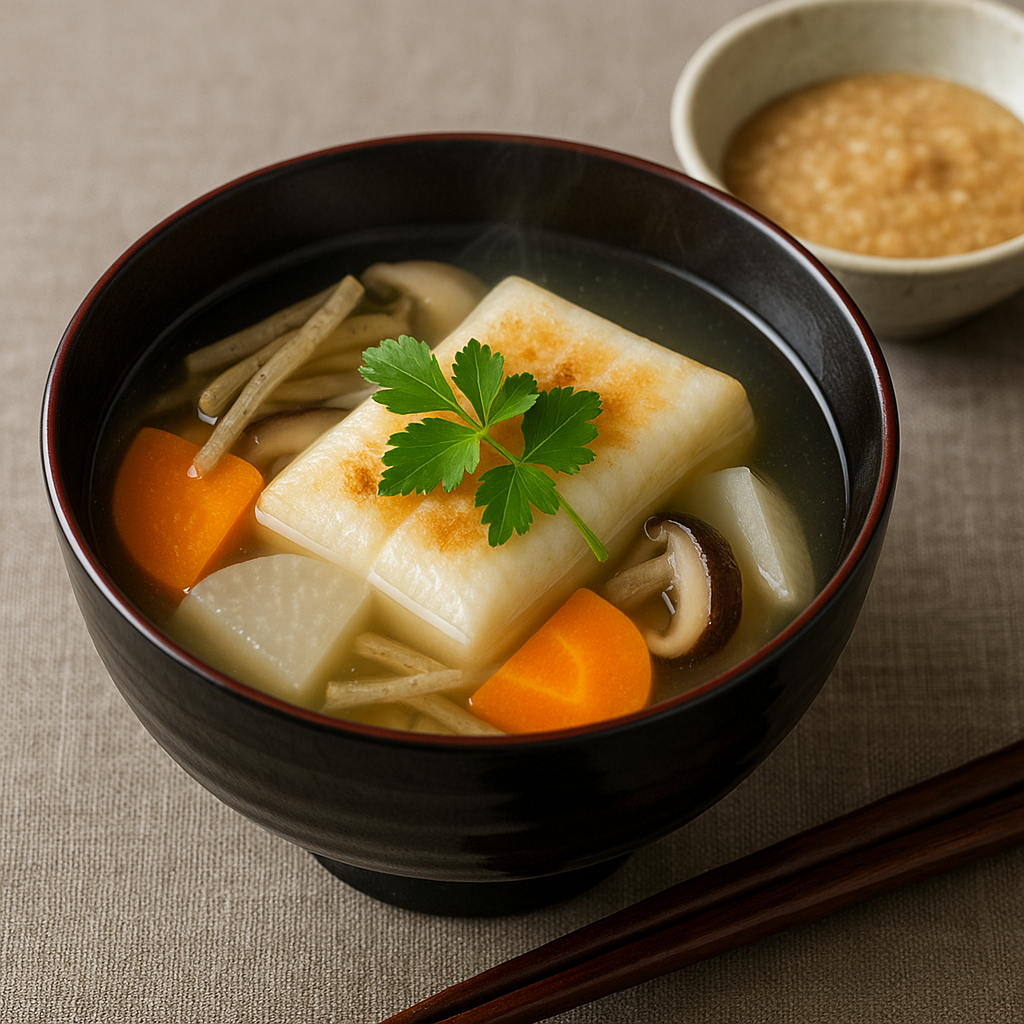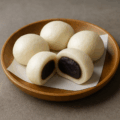くるみ雑煮(岩手)の特徴
香ばしいもちを“くるみだれ”でいただく、北東北の雑煮です
くるみ雑煮は、澄んだしょうゆ仕立ての汁に焼き(または茹で)もちを入れ、仕上げに香り高いくるみだれを添えて味わう岩手の正月料理です。くるみのコクと甘じょっぱさが、だしともちの旨みを引き立てます。
澄まし仕立てが基本。地域や家ごとに具材と“食べ方”が変わります
だしは昆布+かつお(または干し椎茸・煮干し)に、根菜や青菜を合わせるのが定番です。もちにくるみだれをのせる/くぐらせるなど、食べ方にも地域の個性があります。
くるみ雑煮(岩手) レシピ
材料(5人分)
- 切りもち … 10個(1人2個目安/焼き or 煮)
- 大根 … 200g(いちょう切り)
- にんじん … 100g(半月切り)
- 鶏もも肉 … 150g(小さめそぎ切り・任意)
- だし … 1,200ml(昆布+かつお/干し椎茸・煮干しでも可)
- しょうゆ … 大さじ3
- みりん … 大さじ2
- 酒 … 大さじ1
- 塩 … 少々(味の締め)
くるみだれ
- くるみ(むき身・軽く炒る) … 120g
- 砂糖 … 大さじ2〜3
- しょうゆ … 小さじ1
- だし(または水) … 大さじ2〜4(濃度調整)
作り方
- だしを沸かし、鶏肉を入れてアクを引く。大根・にんじん・ごぼう・椎茸を加え、中火で10〜12分煮る。
- 酒・みりん・しょうゆで調味し、塩で味を締める。青菜を加えてさっと温める。
- くるみだれを作る:くるみをすり鉢でペーストにし、砂糖・しょうゆを混ぜ、だしで“とろりと落ちる”濃度にのばす。
- もちを焼く(または湯で柔らかくする)。椀に汁・具をよそい、もちを入れる。
- 食べる直前に、くるみだれをのせる(または別添え)。
シェフのワンポイントアドバイス
- くるみだれは少量ずつだしで調整。濃すぎると絡みにくく、薄すぎると風味がぼやけます。
- もちを焼く場合は軽い焼き目まで。焼きすぎると餅の旨味と甘みが弱まります。
- 鶏肉なしでも上品に仕上がりますが、その場合には干し椎茸の戻し汁を活用する様に。
栄養価(1人分の目安)
- エネルギー … 320〜480 kcal
- たんぱく質 … 8〜15 g(鶏肉・くるみ由来)
- 脂質 … 10〜20 g(くるみ由来)
- 炭水化物 … 45〜70 g(もち・野菜由来)
- 食物繊維・ビタミンE … くるみ・根菜由来
歴史
正月の雑煮に“木の実のたれ”を添える風習が根づきました
岩手では、だしの雑煮にくるみだれを合わせる食べ方が伝わり、正月のお椀にコクと華やぎを添えてきました。
“のせる/くぐらせる”食べ分けに家庭の個性があります
くるみだれをもちにのせる、別椀に用意してくぐらせるなど、所作に地域差があり、家ごとの味として受け継がれています。
English Version
Features of Walnut Zoni (Iwate)
A North Tohoku New Year soup crowned with toasty mochi and walnut sauce
This festive zoni places grilled (or simmered) mochi in a clear soy-seasoned broth, then finishes with an aromatic walnut sauce. The nutty sweetness and gentle saltiness amplify the savor of the dashi and mochi.
Clear-broth style, with family-by-family choices of toppings and how to eat
Dashi is typically kombu + katsuobushi (or dried shiitake / niboshi), with root vegetables and leafy greens. People either spoon the walnut sauce on top of the mochi or serve it on the side to dip—a charming regional custom.
Walnut Zoni (Iwate) – Recipe
Ingredients (Serves 5)
- Kirimochi (rice cakes) … 10 pieces (≈2 per person; toasted or simmered)
- Daikon … 200 g (half-moon/ichō slices)
- Carrot … 100 g (half-moon slices)
- Chicken thigh … 150 g (thin slices; optional)
- Dashi … 1,200 ml (kombu + katsuobushi; or dried shiitake / niboshi)
- Soy sauce … 3 Tbsp
- Mirin … 2 Tbsp
- Sake … 1 Tbsp
- Salt … a pinch (to finish)
- (Optional) Burdock root … 80 g (shaved; soak in water)
- (Optional) Dried shiitake … 4 caps (thinly sliced; use soaking liquid)
- (Optional) Leafy greens (komatsuna/seri/spinach) … as needed (blanched, 3–4 cm)
Walnut Sauce
- Walnuts (shelled, lightly toasted) … 120 g
- Sugar … 2–3 Tbsp
- Soy sauce … 1 tsp
- Dashi (or water) … 2–4 Tbsp (to adjust thickness)
Directions
- Bring the dashi to a simmer; add chicken and skim. Add daikon and carrot (plus burdock and shiitake if using) and simmer over medium heat for 10–12 minutes.
- Season with sake, mirin, and soy sauce; taste and finish with a pinch of salt. Stir in blanched greens briefly to warm.
- Make the walnut sauce: grind walnuts to a paste, mix in sugar and soy, then thin with dashi until it falls in a slow ribbon.
- Toast mochi (or soften in hot water). Ladle broth and vegetables into bowls and add the mochi.
- Spoon the walnut sauce over the mochi—or serve it separately for dipping just before eating.
Chef’s Tips
- Adjust the sauce little by little with dashi: too thick won’t coat; too thin mutes flavor.
- Toast mochi only to a light blush; overbrowning can dull its delicate sweetness.
- Going meatless? Use the shiitake soaking liquid in the dashi for extra depth.
Nutrition (per serving, approx.)
- Energy … 320–480 kcal
- Protein … 8–15 g (from chicken & walnuts)
- Fat … 10–20 g (from walnuts)
- Carbohydrates … 45–70 g (from mochi & vegetables)
- Dietary fiber & vitamin E … from walnuts and root vegetables
History
A New Year bowl enriched with a traditional “nut sauce”
In Iwate, clear-broth zoni paired with walnut sauce adds body and festive flair to the holiday table.
“On top” or “dip”—customs that express each household’s style
Whether the walnut sauce is spooned onto the mochi or served as a dipping sauce varies by locale and family, preserving delightful diversity in this regional classic.



何でも質問してください!